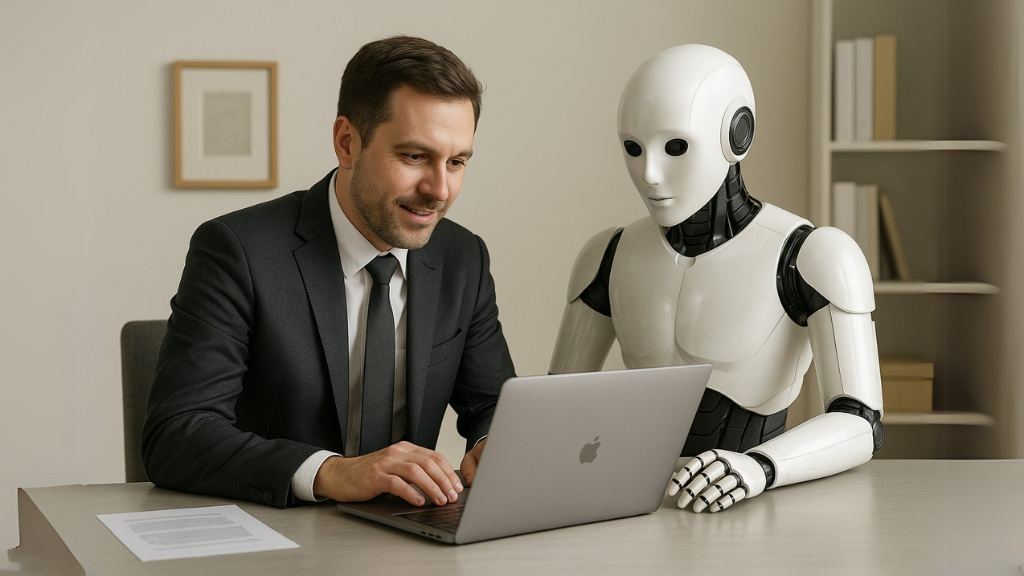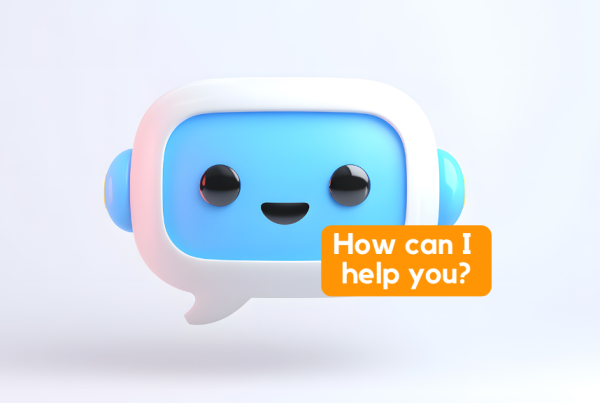Picture this: You walk into your office on Monday morning, and your AI assistant has already reviewed the weekend’s customer feedback, identified three urgent issues, drafted response emails, and scheduled follow-up calls with the affected clients. But here’s the twist—it didn’t send those emails or make those calls. Instead, it left them for you to review, personalize, and approve.
This isn’t science fiction. It’s happening right now in businesses around the world, and it represents a fascinating paradox in our relationship with artificial intelligence. While many people worry that AI will replace human workers, the most successful companies are discovering something different: humans and AI work better together than either could work alone.
What is Agentic AI?
Before we dive deeper, let’s clarify what we mean by “agentic AI.” Unlike the chatbots you might use for customer service or the voice assistants on your phone, agentic AI can take independent action. It doesn’t just answer questions—it can analyze problems, make decisions, and complete tasks without constant human supervision.
Think of agentic AI as a highly capable intern who never gets tired, never forgets details, and can work on multiple projects simultaneously. This AI can research competitors, analyze sales data, draft reports, schedule meetings, and even negotiate simple contracts. The key difference is that it can do these things on its own, following goals you’ve set rather than specific step-by-step instructions.
The Fear vs. The Reality
When most people hear about AI that can work independently, their first thought is often about job security. Will these AI systems replace human workers? The answer, based on what we’re seeing in the real world, is more nuanced and actually more optimistic than many expect.
Companies that have successfully integrated agentic AI aren’t laying off employees—they’re making their existing employees more productive and valuable. Instead of replacing humans, AI is handling the routine, time-consuming tasks that prevent people from doing their best work.
Consider Sarah, a marketing manager at a mid-sized software company. Before her company introduced agentic AI, she spent about 60% of her time on administrative tasks: compiling reports, tracking campaign performance, scheduling social media posts, and managing email lists. Now, her AI assistant handles these routine tasks, freeing Sarah to focus on creative strategy, relationship building, and high-level planning—the things that actually require human insight and creativity.
Where AI Excels (And Where It Doesn’t)
To understand why human-AI collaboration works so well, we need to recognize what each party brings to the partnership.
AI’s Strengths:
- Processing large amounts of data quickly
- Working without breaks or fatigue
- Following consistent processes without variation
- Remembering and cross-referencing vast amounts of information
- Performing repetitive tasks without losing accuracy
- Working on multiple projects simultaneously
AI’s Limitations:
- Understanding context and nuance in human communication
- Making creative leaps or innovative connections
- Handling unexpected situations that require judgment
- Building genuine relationships and trust
- Understanding emotions and reading between the lines
- Making ethical decisions in complex situations
Human Strengths:
- Creative problem-solving and innovation
- Emotional intelligence and relationship building
- Ethical reasoning and moral judgment
- Adapting to unexpected situations
- Understanding cultural context and nuance
- Making intuitive connections between seemingly unrelated ideas
Human Limitations:
- Processing speed for large datasets
- Consistency in repetitive tasks
- Working long hours without fatigue
- Perfect recall of detailed information
- Multitasking without losing focus
Real-World Success Stories
The power of human-AI collaboration becomes clear when we look at specific examples from different industries.
Healthcare: At Cleveland Clinic, AI systems analyze medical scans and flag potential issues for radiologists to review. The AI can spot patterns in thousands of images per hour, but doctors make the final diagnosis and treatment decisions. This collaboration has improved both speed and accuracy—the AI catches things human eyes might miss, while doctors provide the clinical judgment and patient interaction that AI cannot.
Financial Services: Investment firm analysts now work with AI that can process earnings reports, news articles, and market data from hundreds of companies simultaneously. The AI identifies trends and anomalies, but human analysts interpret these findings, consider broader market context, and make investment recommendations. The result is faster, more comprehensive analysis than either humans or AI could produce alone.
Customer Service: Online retailer Zappos uses AI to handle initial customer inquiries and routine issues, but escalates complex problems to human representatives. The AI resolves simple questions instantly, while humans handle the emotional, creative, or complex problem-solving that requires empathy and out-of-the-box thinking. Customers get faster service overall, and human agents can focus on the interactions where they add the most value.
The Technology That Makes It Work
For human-AI collaboration to be effective, businesses need the right technological foundation. This goes beyond just having AI software—it requires systems that facilitate smooth cooperation between humans and AI agents.
Transparent Decision-Making: The best AI systems show their work. When an AI makes a recommendation or completes a task, it should be able to explain its reasoning in terms humans can understand. This transparency allows humans to verify AI decisions, learn from the AI’s analysis, and intervene when necessary.
Flexible Handoffs: Effective collaboration requires seamless transitions between AI and human work. An AI might start a task, hand it off to a human for creative input, then take it back for implementation. The technology needs to support these smooth handoffs without losing context or momentum.
Learning Systems: The most successful human-AI partnerships involve systems that learn from human feedback. When a human corrects an AI’s work or makes a different decision, the AI should understand why and improve its future performance accordingly.
User-Friendly Interfaces: For collaboration to work, humans need to interact with AI through intuitive, web-based interfaces that don’t require technical expertise. The technology should feel like working with a very capable colleague, not operating complex machinery.
Overcoming the Collaboration Challenges
While human-AI collaboration offers tremendous benefits, it’s not without challenges. Understanding these challenges helps businesses implement AI more successfully.
Trust Building: Many employees are initially skeptical of AI recommendations. Building trust requires starting with low-stakes tasks where employees can verify AI performance and gradually expanding to more important decisions as confidence grows.
Clear Role Definition: Confusion about who’s responsible for what can paralyze collaboration. Successful implementations clearly define which decisions AI can make independently, which require human approval, and which are purely human responsibilities.
Training and Adaptation: Employees need to learn new skills to work effectively with AI. This includes understanding AI capabilities and limitations, interpreting AI outputs, and knowing when to override AI decisions.
Ethical Considerations: As AI takes on more responsibilities, businesses must establish clear ethical guidelines about AI decision-making, especially in areas affecting customers, employees, or business partners.
The Productivity Multiplier Effect
When human-AI collaboration works well, it creates a multiplier effect that goes beyond simple task automation. Humans become more productive not just because AI handles routine work, but because the partnership enables entirely new ways of working.
Consider a small marketing agency that implemented agentic AI. The AI doesn’t just automate existing processes—it enables the agency to take on more sophisticated projects. The AI can monitor dozens of client campaigns simultaneously, analyze performance data in real-time, and suggest optimizations, allowing human strategists to manage more clients while providing better service to each one.
This multiplier effect is particularly powerful for small and medium-sized businesses that previously couldn’t afford to hire specialists for every function. An AI assistant can provide expertise in areas like data analysis, market research, or competitive intelligence, effectively giving a small team capabilities that would otherwise require a much larger staff.
Looking Ahead: The Future of Collaboration
As AI technology continues to improve, the nature of human-AI collaboration will evolve, but the fundamental principle—that humans and AI complement each other—is likely to remain constant.
We can expect AI to become better at understanding context, communicating naturally, and handling more complex tasks independently. However, humans will continue to excel at creative problem-solving, relationship building, and ethical decision-making.
The businesses that thrive in this environment will be those that thoughtfully design human-AI partnerships rather than simply adding AI tools to existing processes. This means rethinking workflows, redefining job roles, and creating systems that leverage the best of both human and artificial intelligence.
Making Collaboration Work for Your Business
If you’re considering how agentic AI might benefit your business, start by identifying tasks that are routine, data-intensive, or time-consuming but don’t require creative judgment or relationship skills. These are ideal candidates for AI automation.
Next, consider how freeing up time from these tasks would allow your team to focus on higher-value activities. What strategic projects have been pushed aside because everyone’s too busy with day-to-day operations? What customer relationships could be deeper if your team had more time to invest in them?
The goal isn’t to replace human workers with AI, but to create partnerships that make your human workers more effective, creative, and valuable. When done right, human-AI collaboration doesn’t just improve efficiency—it makes work more interesting and fulfilling for the humans involved.
The Paradox Resolved
The collaboration paradox—that humans and AI work better together than separately—resolves when we recognize that intelligence isn’t a zero-sum game. AI doesn’t diminish human value; it amplifies human capabilities while handling tasks that humans find tedious or overwhelming.
The most successful businesses of the next decade won’t be those that choose between humans and AI, but those that master the art of bringing them together. In this partnership, AI provides the processing power, consistency, and tireless work ethic, while humans contribute creativity, judgment, and the irreplaceable ability to understand and connect with other humans.
The future belongs not to humans versus machines, but to humans with machines, working together to achieve more than either could accomplish alone.




